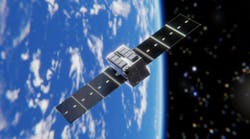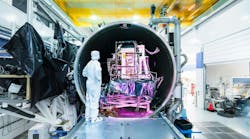By John Rhea
WASHINGTON - It's the sensors, stupid.
Designers of the proposed $14 billion National Missile Defense (NMD) system face a fundamental problem. There is growing concern whether the infrared sensors on the NMD's kinetic kill vehicles can discriminate between incoming nuclear warheads and the decoys that are likely to accompany them. They must if NMD is to succeed.
This represents a severe technological challenge to the military electronics industry. In the past the challenge centered on computing - the quest for the so-called supercomputer in a coffee can. Moore's law, however, has taken care of that. Moore's Law, from Intel Corp. co-founder Gordon Moore, holds that processing power at the chip level doubles every 18 months at no increase in cost. President Clinton must decide this fall if the NMD system is to go into operation in 2005.
At stake for the industry is a huge market for state-of-the-art electronic subsystems, many of them readily transferable from existing weapons programs. They will be necessary to perform the missile-defense functions of surveillance, target acquisition, and battle management.
For this to happen, missile-defense sensors must be able to discriminate between actual warheads, and the anticipated decoys that most likely will take the form of balloons. Yes, balloons. In the near vacuum of space these balloons tumble like warheads, which complicates the job of the defenders.
This is what the current series of tests at the Defense Department's Ballistic Missile Defense Organization (BMDO) is about. The kill vehicle, which launches from the Kwajalein Atoll in the Pacific Ocean, has a cryogenically cooled (nitrogen and krypton) 256-by-256-element focal plane array that acts like a telescope to enable the vehicle to home in on the warhead and destroy it kinetically on impact.
The target is a modified Minuteman 2 intercontinental ballistic missile launched from Vandenberg Air Force Base, Calif. The target missile carries one warhead and one decoy. Test procedures require a Defense Support Program (DSP) surveillance satellite to acquire this target early in its trajectory, and then hand targeting data off to an X-band radar. This X-band radar data links the initial coordinates to the kill vehicle.
An operational system would handle this function in space with a high-orbit Space-Based Infrared System (SBIRS) satellite with 10 times the capability of DSP, and on the ground with a dedicated X-band radar at Shemya at the tip of Alaska's Aleutian Islands chain. A second, low-orbit, SBIRS satellite eventually is to provide even greater tracking accuracy.
Under heavy pressure from Congress to get the NMD up and running, Defense Department leaders have scheduled at least 16 more intercept tests — eight of them in 2003. Then top U.S. leaders will decide whether to produce an operational NMD system. If national leaders go ahead with the system, the X-band radar and the first 20 interceptors would be operational in 2005 and 80 more interceptors would be available by 2007.
Given the Defense Department's decision to intercept the warheads in space (more about that later), the problem becomes one of phenomenology, says John Pike, head of the Washington-based Federation of American Scientists. "The sensors can't extract the signatures," he maintains. If the defenders face 10 incoming balloon-like objects, he says, they have no way to tell which contain warheads — maybe one or two, or maybe all of them.
As in football, the offense takes what the defense will allow. The so-called "rogue states" that worry Congress — North Korea, Iraq, and now Iran — have it relatively easy. All they have to do is develop nuclear warheads, delivery vehicles, and decoys; the decoys are the easiest of the three.
Insoluble problems
Ted Postol, professor of science, technology, and national security policy at the Massachusetts Institute of Technology in Cambridge, Mass., zeroes in on this sensor problem, which he contends is insoluble. The X-band radar, he says, can tell only range, but not azimuth and elevation, which means that the kill vehicle cannot depend on it for accurate initial targeting information.
The incoming targets and the kill vehicles will have a closing speed of more than 10 kilometers per second — that's faster than 22,000 miles per hour — and the final phase of the kill will begin at a range of about 600 kilometers, Postol adds. These conditions give the kill vehicle's onboard sensors and processors less than a minute to discriminate conclusively between warheads and decoys.
Jacques Gansler, U.S. undersecretary of defense for acquisition, technology, and logistics, concedes that the sensor problem is daunting, calling it a "core point," but bases his confidence on 40 years of DOD research on decoy signatures — much of it in which he was personally involved.
"So the experts — in fact, the people working for us on the contracts and the independent assessors — have all felt that this system has the inherent capability to be able to deal with those threats as they come along, and we will, of course, continue to make it more sophisticated as those threats evolve," Gansler told a Pentagon news briefing.
The whole issue of anti-ballistic missile (ABM) defense goes back far beyond even Gansler's watch at the Pentagon. Experts in think tanks did conceptual studies shortly after the end of World War II. On Sept. 30, 1958, leaders of the predecessor to today's Defense Advanced Research Projects Agency launched a program to determine whether enemy ballistic missiles could be destroyed from space as they rose from their silos.
The program was known as Ballistic Anti-Missile Boost Intercept, which yielded the unfortunate acronym BAMBI, and it limped along until 1968, when U.S. Army leaders grabbed the ball. The Army program took the opposite approach: knocking down the missiles in the terminal phase of their trajectory as they reentered the Earth's atmosphere and sped toward their intended targets. This would require nuclear warheads on the defending ABM vehicles. Understandably this made many people uncomfortable when they thought about nuclear warheads detonating over their heads.
Limited-defense goal
Known variously as Safeguard and Sentinel, Army program managers intended it counter the "rogue states" of that time, principally Communist China. They never intended it to be a "leak-proof" defense against a sophisticated adversary such as the then-Soviet Union. The NMD, as U.S. leaders now envision it, is not to be a leak-proof system against a sophisticated adversary, either.
A more-grandiose vision temporarily emerged on March 23, 1983, with President Reagan's so-called Star Wars speech creating the Strategic Defense Initiative, or SDI, and promising to make nuclear weapons "impotent and obsolete." Reagan's SDI vision was never developed.
It's doubtful at this moment whether anybody other than Reagan took SDI seriously, but it did contribute to forcing the two superpowers to back off from their nuclear confrontation and thus create the climate for ending the Cold War. As one military insider at the time put it, SDI was "the bluest of the blue chips" to be bargained away for the resulting strategic arms limitations being implemented today.
Where these blind alleys of the past are relevant today is in the variety of options available for fulfilling the NMD mission. It's probably not economically feasible today to knock out the incoming missiles with surface-launched defenders during the terminal phase, or in space with space-based weapons (lasers or the once popular notion of "smart rocks" kinetic kill vehicles). The attackers can simply add a few more warheads and decoys to overwhelm the defenders — just as a combination of a good running game and a good passing game in football can frustrate a competent defensive unit.
However, Postol and others raise the possibility of using surface-launched conventional kill vehicles to attack the missiles during the boost phase. Their reasoning is that the missiles are likely — initially at least — to be relatively primitive Scud-type missiles such as those used a decade ago in Iraq during the Persian Gulf War.
Although this approach carries with it severe logistics problems, one possibility is to use refurbished Ohio-class Trident ballistic-missile submarines to move the kill vehicles close to the borders of the rogue states. This would not be difficult against North Korea. The same approach could also be used against Iraq, although another possibility is ground-launched vehicles from bases in Turkey. Another option could be to use the U.S. Air Force's Airborne Laser (ABL), although that also involves logistics problems.
Russian cooperation would be necessary to counter missiles launched from Iran since the defenders would likely need access to the Caspian Sea. Russian cooperation may be necessary for NMD anyhow since the program violates the 1972 ABM Treaty. The United States has a choice of either working out a deal with the Russians or going it alone, and the latter choice raises the possibility of resurrecting the dormant arms race. However, the technical problems seem to be more intractable than the diplomatic ones.
Schedule driven
In their hurry to respond to Congress, NMD team members may be under such pressure that they are unable to evaluate all the alternatives adequately. A classified report prepared by former Air Force Chief of Staff Gen. Larry Welch currently circulating around the Pentagon reportedly calls their approach a "rush to failure."
Gansler admits that NMD may have been too "schedule-driven" and not sufficiently "event-driven," based on tests to date. Nonetheless, he contends that the program has been modified to satisfy the objections of the Welch panel.
From the electronics industry's point of view, NMD represents a potential windfall. Not only is it likely to be a major market for top-of-the-line signal processing and other computational hardware and software, but it can be a source of old-fashioned technology spinoff from military-funded research. Like NASA, BMDO has been eager to share this technology, in part to justify its own existence, and has a valuable web site for this purpose: http://www.acq.osd.mil/bmdo/bmdolink/html/transfer.html.
The worrisome part is getting there from here. The whole field is littered with the corpses of previous failed ABM programs. Despite what Gansler says, NMD is a schedule-driven program with one foot in the grave and the other on a banana peel.
NMD could be a vital capability in the post-Cold War world, but the necessary supporting technology cannot be developed on a schedule set by Congress. There's too much at stake to get locked in now with an approach that will hit a brick wall a few years down the road.



